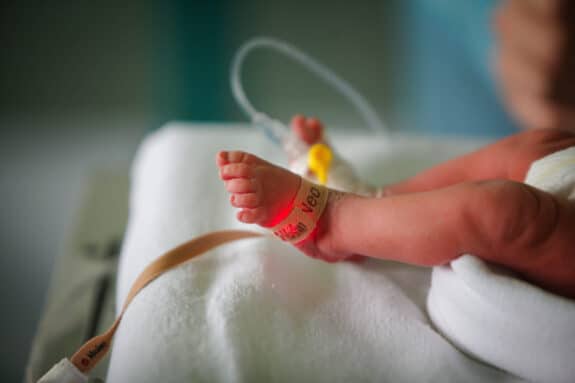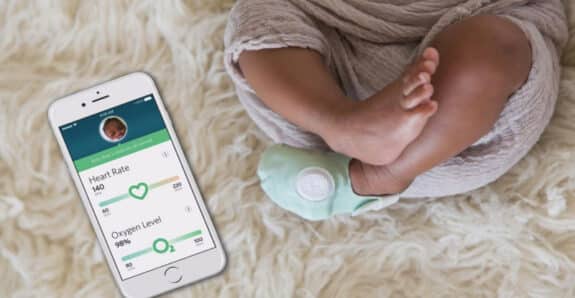One of the newest ways to supervise your baby is to keep track of their vitals through a wearable oxygen monitor. Much like a home pulse oximeter they monitor heart rate and detect low oxygen in the baby’s blood – something that could signal bigger issues for a newborn.
Pediatrician, safety expert at Children’s Hospital of Philadelphia (CHOP) and lead researcher Dr. Chris Bonafide is raising serious concerns about the accuracy of the Baby Vida and Owlet Smart Sock 2 devices after his team’s tests revealed both monitors gave inconsistent readings.
“These are sold just as consumer products, yet are being compared to hospital-grade monitors,” Bonafide said. “I think we’ve shown here that’s not a fair claim to make. They’re clearly not performing at the level of hospital-grade monitors.”
Monitor manufacturers tout the devices as a way peace of mind for new parents. Dr. Rachel Moon, who chairs the AAP Task Force on SIDS is concerned they provide a false sense of security.
“My main concern is people become complacent. They decide that since the baby’s monitored it’s OK for them to not practice safe sleep,” said Moon, head of pediatrics for the University of Virginia School of Medicine. “Using a monitor is a lot easier than practicing safe sleep. And then if the monitors don’t work, you’re just in a horrible situation then.”
For their study, Bonafide and his colleagues tested the devices on 30 infants aged 6 months or younger in CHOP’s cardiology and general pediatrics units during the last half of 2017.
Each baby wore a U.S. Food and Drug Administration-approved hospital-grade monitor on one foot and a consumer monitor on the other foot.
None of the 14 infants who experienced low oxygen levels according to the hospital-grade monitor had simultaneous low oxygen readings on the Baby Vida, which appears to be no longer on the market.
Additionally, the Baby Vida also falsely displayed a slow heart rate in 14 babies who had a normal pulse.
“It had problems with false negative values and false positive values, in the same monitor,” Bonafide said.
Researchers noted that the Owlet device did detect low oxygen levels in all 12 patients who had their blood oxygen drop below normal. But it indicated that five of the 12 babies had normal oxygen levels at least once during these extended periods of low oxygen.
“Sometimes when those babies did have low oxygen saturation, the Owlet inconsistently would display normal oxygen saturation,” Bonafide said.
The Owlet detected low oxygen levels accurately nearly 89 percent of the time. But that is not good enough if your baby isn’t well.
“If something is going wrong with a sick infant, you would want to know that 100 percent of the time,” Bonafide said.
Kurt Workman, co-founder, and CEO of Owlet immediately addressed the study saying,
“The accuracy and performance of the Owlet Smart Sock is something we take very seriously. It is important to note that our product is designed for in-home use, with healthy babies while they sleep, to provide parents with information about their child’s wellbeing. As the CHOP study states, one of the limitations of their methodology was not using arterial blood gas measurements. Owlet’s sensor accuracy was tested against arterial blood gas measurements in December 2017 and the sensor performed well within industry and regulatory standards for pulse oximetry, which require devices to perform within 3% Accuracy Root Mean Square (ARMS). In January 2018, Owlet also tested its sensor accuracy in babies between 0 and 17 months against the Masimo Radical-7, a hospital-grade device, with both sensors on one foot and reached desired industry accuracy standards, comparing favorably to Masimo Radical-7.”
He also raised the following concerns about how the study was carried out:
- The study included high-risk, primarily late premature babies (median gestational age 39 weeks). Owlet’s intended use is on healthy babies in the home.
- For all 12 patients where the control device detected low oxygen, the Owlet Smart Sock notified of at least one O2 occurrence. Clinicians often use saturation data as an indicator of an acute problem, or an exacerbation of a chronic problem. In the majority of those cases, it is the trend of saturation, not a single point that will direct a course of action. To that end, there is nothing in this study that undermines the benefits of Owlet.
- There was no mention of whether babies were moving or not as this can significantly alter results, especially in this population. Owlet is intended to be used while babies are sleeping.
- The reference device (Masimo) and test device (Owlet) were on opposite feet which is against industry standards for such comparisons.
As the mom of a former preemie, I know that parent’s bringing their premature babies home are using this device as they are well educated on oxygen stats from the NICU and want to make sure their babies aren’t having issues.




